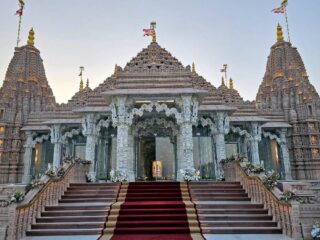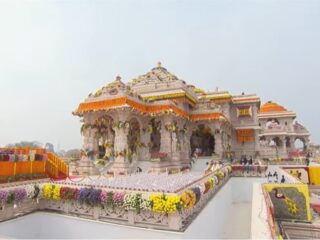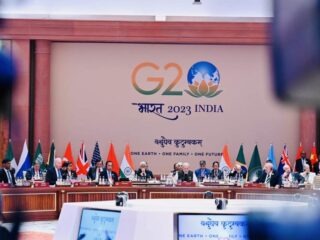Dara Shukoh – Why is the Philosopher Prince invoked today?
Neha Dabhade
(Secular Perspective Feb.16-28, 2017)
Recently Dalhousie road in New Delhi has been renamed after Dara Shukoh by the New Delhi Municipal Corporation. The proposal was put forward to NDMC by BJP MP Meenakshi Lekhi who is also a council member. She explained the demand of such renaming by saying, “The council has decided to rename the road to honour Dara Shukoh for bringing Hindus and Muslims together” (The New Indian Express, 2017). Lord Dalhousie was the Governor General of India from 1848 to 1856. Though such a change may seem routine and mundane, the move is significant and also political. Political in a sense, that renaming streets is also a way of endorsing or validating historical figures and their contribution. For those who haven’t heard Dara Shukoh’s name before, he was the Mughal Emperor Shahjahan’s eldest son who was also his favorite and crowned prince designated to succeed him. But he was defeated by his brother Aurangzeb who went on to become the Emperor of India. Ironically, in August 2015 a street named after Aurangzeb was renamed after former President of India, APJ Abdul Kalam. The politics of bloodletting and sibling rivalry for gaining power and throne are very common in history. Then why is Dara Shukoh, a defeated Mughal Prince, remembered today by the political dispensation?
Dara Shukoh, though in history will be the vanquished prince, he has to his credit an illustrious life full of incredible scholarship. He studied Hindu religion and translated the Upanishads in Persian. Along with Upanishads, Bhagwat Gita, he also studied the Talmud and the New Testament. He was a mystic, a Sufi and a person seeking truth and spirituality. But it’s anyone’s guess that his scholarship and attempt to counter bigoted thought and beliefs is not the reason why the renaming of the road is taking place. Dara Shukoh was executed by his ‘bigot’ brother Aurangzeb by charging that Dara Shukoh “apostatized from the law and having vilified the religion of God had allied himself with heresy”. This seeming cruelty by Aurangzeb to a brother who studied Hindu religion, makes Dara Shukoh an acceptable figure for Hindu Nationalists who cite him as an example of harmony between Hindus and Muslims. Since Dara Shukoh is revoked by politics today in the discourse of who becomes a “good” Muslim and whose name can be honored by having them exhibited in public spaces, at this point of time, it is imperative to revisit Dara Shukoh to understand his life and his works.
As mentioned earlier, Dara Shukoh (1615-1659) was the eldest son of Emperor Shahjahan and Mumtaz Mahal. Before the birth of Dara Shukoh at Sagartal near Ajmer, Shahjahan only had daughters and thus he made supplications at the shrine of the great Sufi Saint Khwaja Mouiddin Chisti for a son. His prayers were answered and the Emperor rejoiced the birth of his eldest son. Dara Shukoh had three other brothers, Shuja, Aurangzeb and Murad. But Dara Shukoh remained the closest to his father. Though the other sons were sent on assignments and conquers far away, Dara Shukoh was always kept at the court of the Emperor so that he was in the company of his father. Dara Shukoh from his early age was more inclined towards mysticism and philosophy than military pursuits. This gained him the epithet of the Philosopher Prince.
Dara Shukoh though is inevitably compared to his great grandfather Akbar in matters of patronizing scholars of other religions and undertaking comparative study of religions, there is a significant distinction between the two. Akbar’s motive of deliberation with scholars from different religions and tolerance was political and to consolidate his power in India. Dara Shukoh had no motive of power or worldly things. He undertook the study of different religions for seeking truth. He truly believed that no religion had monopoly over truth. Truth could be found in different religions and truth was manifold.
The early beginning of his journey of spirituality started with his acquaintances of great Sufi saints. He was closely associated with Miyan Mir and Mulla Shah Badakhshi. He undertook studies in mysticism. He got initiated into Qadiri Sufi Silsila. He was so entrenched into Islamic mysticism that he wrote 6 books on Sufism. In the first book itself, when he was 25 years old, he recorded the lives of almost 411 Islamic saints and divines including the Prophet and his wives. He condemned the Mullahs who interpreted Islam in a rigid way which led to dogmatism and intolerance. His study of Sufism made him realize that to be one with God one doesn’t need rituals or priests but only love and selfless surrender.
He didn’t keep the company only of mystics from the Sufi tradition. He closely associated himself with Baba Lal Das Bairagi who was a follower of Kabir and Jagannath Mishra. He studied along with the mystic traditions from different religions, Hindu mythology, Vedanta philosophy, Psalms, the Gospel and the Pentateuch. He also accepted counsel in spiritual matters from Reverend Father Buzee. He sought the company of Sanyasis of Beneras and Pandits to understand the Hindu scriptures better.
One of the most acclaimed works of Dara Shukoh was ‘Majma-ul- Bahrain’ or the ‘Mingling of the Two Oceans’. In this work, Dara Shukoh has attempted to reconcile the doctrines of Islam and Hinduism by finding common ground between the two. He says, “… Majma-ul-Bahrain is a collection of the truth and wisdom of two truth-knowing groups”. In this work, Dara Shukoh elucidates on the points where the two apparent divergent or discordant religions meet. This revealed his inclination to pluralism of truths and religions by showing through his study that Hinduism and Islam have points in common and thus complement each other. It strengthened Indo Islamic thought in India which was broad based and Syncretic in nature. He didn’t uphold that one religion is superior to another. His interpretation of religions was inclusive and liberal. He says, “If I know that an infidel (Hindu), immersed in sin, is in a way, singing the note of monotheism, I go to him, hear him and am grateful to him” (Hasrat, 1982).
Again Dara Shukoh becomes relevant today because when the Hindu nationalists resort to reassert in the supremacy of “Indian” culture which they claim to be steeped in historical traditions. These traditions cited are always from ‘Hindu’ culture, as if there was no exchange of thought or cultural contribution from Islam in India. In this regard, the book Majma-ul-Bahrain is a significant contribution since it comments on commonality in both religions. Both religions lead to Truth. The book dealt with many aspects like elements, senses, devotional exercises, and soul in its 22 sections. But what is striking is the comparison of attributes of God in both religions. In Islam, the Divine has attributes of Jamal or Beauty and Jalal or Majesty. In Hinduism, the three attributes are called Brahma, Vishnu and Mahesh denoting creation, duration and destruction respectively. These are identical to the Jibrail, Mikail and Israfil in Islam. Jibrail is the angel of creation, Mikail is the angel of duration or existence and Israfil is the angel of destruction. This goes on to show that there is no fundamental difference in some of the most important aspects from both religions.
The concept of Tawhid really interested Dara Shukoh. This stemmed from his earnest belief in pluralism and yet that different paths lead to the same God or Divine. He famously said, “Here is the secret of Tawhid, O friend, understand it; Nowhere exists anything but God. All that you see or know other than Him, Verily is separate in name, but in essence one with God.” (Sengupta, 2015)
The search for Tawhid or Unity of God and monotheism got Dara Shukoh to study many religious scriptures. The Holy Quran itself has many secrets whose interpretations were difficult to find. He tried to find the solutions and the possible answers to his questions in the revealed books of religions which apparently believed in monotheism. But this led only to frustrations and dissatisfaction since no questions were answered from these books. Dara Shukoh then resorted to find the answers in Hindu scriptures and translated 50 chapters of the Upanishads.
He found answers to his earlier unresolved dilemmas and inquiries. He henceforth considered the Upanishads the ‘first heavenly book’ and the ‘fountainhead of the ocean of monotheism’. He goes on to explain that the Upanishad is the Kitab-i- Maknun or the hidden book whose reference is in the Quran. The Quran states, “Indeed there is a book, which is hidden. None shall touch it but the purified ones. It is a revelation by the Lord of the worlds”. (Quran LVI: 78-81)This translation of the Upanishads was titled as the ‘Sirr-e-Akbar’ or the Great Secret. This is significant because it demonstrates the liberal and broad thinking of Dara Shukoh who was willing to seek truth or understand the unexplained phenomenon from scriptures of other religions. In today’s times the fanatical elements in Islam claim the infallibility of the Quran and consider it as the last word and on the other hand the Hindu nationalists swear by the supremacy of the Bhagwat Gita to an extent where they propose that it should be made compulsory in schools. This indicates towards supremacist and dogmatic tendencies. But Dara Shukoh in order to understand his own religion better sought the knowledge from other religions and readily accepted that other religious scriptures could explain his own religion better to him.
Overall Dara Shukoh sincerely pursued the path of study of comparative religions. He didn’t give up Islam in fact he was a devout Muslim but used other religions to increase his understanding of Islam. He studied Hinduism because he saw an inherent harmony between Islam and Hinduism. He believed that the conflicts may arise on the aspects of rituals but in spiritual matters the two religions can easily reconcile. In that sense his contribution to syncreticism in India is valuable. But is it enough to honour him merely by changing the name of a street in Delhi?
There is politics to naming and renaming entities in public spaces. It reinforces stereotypes. By pitting Dara Shukoh against Aurangzeb and creating a dichotomy of ‘acceptable’ and non acceptable’ Muslim historic figures, the Hindu nationalists are trying to establish a norm and an order. Apart from communalization of history by vilifying Mughal rulers like Aurangzeb through painting them as bigot zealots and cruel, such selective favoring of Muslims is also in effect setting up a litmus test for the country as to who will qualify as “acceptable”. By revisiting the life and ideas of Dara Shukoh one can reflect if the very ideas of Dara Shukoh that are cited as the reason for honoring him are being respected in India today.
In the atmosphere where Hindu religion is hailed to be supreme over all other religions, does the idea of pluralism as understood by Dara Shukoh figure in the policies formulated by the State? By making yoga mandatory for example, does the State remember Dara Shukoh’s doctrine of liberal philosophy and different ways or religions lead to one God? Didn’t he fight the very bigotry that we witness in India today? How does the cow become so holy and people are killed and beaten up for it that it is forgotten that Dara Shukoh emphasized on looking beyond superficial symbols of religion but to focus on commonalities between religions? Do the ideas of Dara Shukoh really resonate in way culture is explained and understood by the State? If not then renaming a street in the honor of Dara Shukoh is only a tainted hollow political gesture.
————————————————
Centre for Study of Society and Secularism
Mumbai




